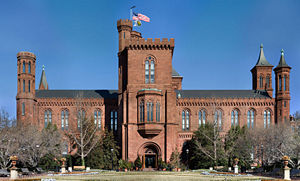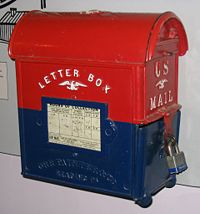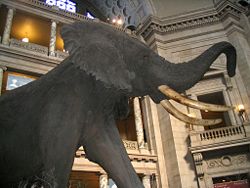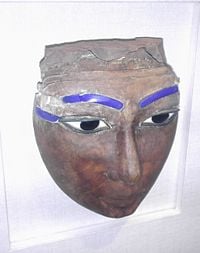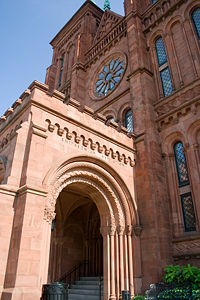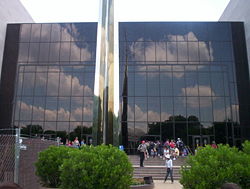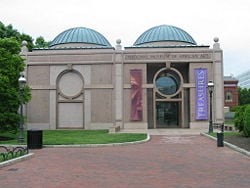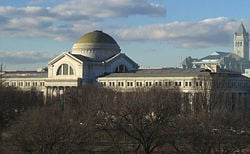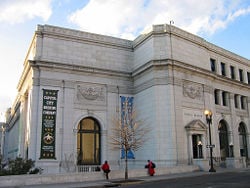Smithsonian Institution
The Smithsonian Institution is the world's largest educational and research institute and museum complex, administered and funded by the government of the United States and by endowments, contributions, and revenues from its retail stores and publications. Most of its facilities are located in Washington, D.C., including the National Zoo, but its 19 museums and eight research centers include sites in New York City, Maryland, Virginia, Panama, and elsewhere.
The Smithsonian's popular Air and Space Museum houses the most historic artifacts from the age of flight, including the iconic Wright Brothers 1903 Flyer and the landing module from the 1969 Apollo 11 flight to the moon. In all the Smithsonian has over 140 million items in its collections. It receives thirty million visitors annually, and access to the institution's museums and galleries are free and open to the public.
The Smithsonian has been criticized for its copyright restrictions, limiting of public access to some holdings, and, along with other museums, its acquisition and retention of Native American remains. Regardless of these disputes, the Smithsonian Institution works across a broad spectrum of interdisciplinary sciences as a leading research center and innovative public education resource to deepen our understanding and appreciation of the natural world and its diverse human cultures.
History
The history of the Smithsonian Institution is as complex as the organization itself. In 1826, the British scientist James Smithson created his last will and testament in which he stated that should his nephew, Henry James Hungerford, die without heirs, the Smithson estate would go to the United States of America for creating an "Establishment for the increase & diffusion of Knowledge among men." The exact reason for this request is unknown, for Smithson never visited America nor did he seem to have any ties to the country.
Nonetheless, after his nephew died without heirs in 1835, President Andrew Jackson informed Congress of the bequest, which amounted to 104,960 gold sovereigns, or $500,000 U.S. dollars. Given the questionable intent of Smithson in making this bequest, Congress debated extensively regarding the nature of the institution. Proposals included a national university, museum, library, observatory, research institute, and an institute to promote science. Finally, in 1846, Congress passed an act establishing the Smithsonian Institution, a hybrid public/private partnership, and the act was signed into law on August 10, 1846, by James K. Polk.[1]
Physicist Joseph Henry was selected as the first Secretary of the institution. He envisioned it as a scientific research institute, carrying out programs of weather observation and instituting the International Exchange Service whereby scientists could gain access to scholarly publications from around the world. Since the institution was created with the requirement that the public have access, Henry conducted a series of public lectures as well as inviting other prominent speakers.
In 1855, the Smithsonian Institution Building on the National Mall, designed by architect James Renwick, Jr., was completed. Its crenellated architecture has made it known informally as "The Castle." It housed laboratories, a science museum, art gallery, lecture hall, office, and living quarters for resident scientists. When meteorologists received word of impending storms they signaled from the tower. Henry was careful to keep the institution separate from politics, flying no flag during the American Civil War.[2]
Many of the other buildings of the institution are historical and architectural landmarks. Detroit philanthropist Charles Lang Freer's donation of his private collection for the Freer Gallery, and funds to build the museum, was among the Smithsonian's first major donations from a private individual.[3]
Development of collections
Although the Smithsonian's first secretary, Joseph Henry, wanted the Institution to be a center for scientific research, before long it became the depository for various Washington and U.S. government collections. The voyages of the U.S. Navy had circumnavigated the globe between 1838 and 1842, and the United States Exploring Expedition amassed thousands of animal specimens, an herbarium of 50,000 examples, shells and minerals, tropical birds, and jars of sea water and ethnographic specimens from the South Pacific. These specimens and artifacts became part of the Smithsonian collections, as did those collected by the military and civilian surveys in the American West, such as the Mexican Boundary Survey and Pacific Railroad Surveys, which assembled many Native American artifacts as well as natural history specimens.
The Institution became a magnet for natural scientists from 1857 to 1866, who formed a group called the Megatherium Club. Such expeditions added to the Smithsonian collection, but it also relied heavily on donations of private collections, particularly with regard to works of art.
By the beginning of the twentieth century, American involvement in global affairs led the acquisition of specimens, particularly those of anthropological nature, at an ever increasing rate. At the same time, the Smithsonian became a growing repository for national treasures, such as the Wright Brothers 1903 Flyer and the 1969 Apollo Moon Lander, as well as presidential artifacts not held by private presidential libraries. Cooperation with other institutions around the world led to trading and purchasing of works of art and specimens. Along with the recognition of the history of African and Native Americans in the U.S., diversification of the collection led to sub-divisions within the Smithsonian that created separate institutions focused on the display of particular collections.
Mission
Despite its large size and complexity, the Smithsonian Institution is guided by the same principles and vision as most of the museums and research facilities around the world. Through research in nearly every humanistic and scientific discipline, the Smithsonian strives to gather a complete vision of the world and its people.
The accumulation of such knowledge is first and foremost for the dissemination to the public; the Smithsonian Institution is a public organization and therefore believes it is responsible for sharing its information firstly to the American public, but also to the world at large. The Smithsonian thus has several museums that display specimens and offer interactive exhibits, publishes research and magazines, and engages the educational system with learning opportunities. Over the course of its history, the Smithsonian has realized the need not just for study but also preservation. Whether it be wildlife, the environment, artifacts, or culture, the Institution now devotes many resources to safe-guarding, as well as studying, the world and its people.[4]
Organizational structure
The Smithsonian Institution was established as a trust instrumentality by act of Congress, and it is functionally and legally a body of the federal government. More than two-thirds of the Smithsonian's workforce of some 6,300 persons are employees of the federal government. The Smithsonian is represented by attorneys from the United States Department of Justice in litigation, and money judgments against the Smithsonian are also paid out of the federal treasury.
The nominal head of the Institution is the Chancellor, an office which has always been held by the current Chief Justice of the United States. The affairs of the Smithsonian are conducted by its 17-member board of regents, eight members of which constitute a quorum for the conduct of business. Eight of the regents are United States officials: The Vice President (one of his few official legal duties) and the Chief Justice of the United States, three United States Senators appointed by the Vice President in his capacity as President of the Senate, and three Members of the U.S. House of Representatives appointed by the Speaker of the House. The remaining nine regents are "persons other than Members of Congress," who are appointed by joint resolution of Congress. Regents are allowed reimbursement for their expenses in connection with attendance at meetings, but their service as regents is uncompensated. The day-to-day operations of the Smithsonian are supervised by a salaried "Secretary" chosen by the board of regents.
Institutions
There are numerous museums, galleries, and other public facilities that are either a part of or associated with the Smithsonian Institution. Below is a list of the major individual facilities.
Washington, DC
- Anacostia Community Museum: Beginning as a museum on the local history of the Anacostia community, the museum now is dedicated to the history and culture of the African American experience. Features an on-line interactive educational database.
- Freer and Sackler Gallery: Named after Arthur M. Sackler the medical doctor that donated his collection of art to Smithsonian upon his death, and for Charles Lang Freer who donated his collection to the Smithsonian, the museum houses a large collection of Asian artwork.
- Arts and Industries Building: The original building of the National Museum.
- Hirshhorn Museum and Sculpture Garden: The Smithsonian's museum dedicated solely to contemporary and modern artwork.
- National Air and Space Museum: Perhaps the most famous of all Smithsonian museums, the institution specializes in the history of aviation and space exploration, and houses such famous aircraft as The Spirit of St. Louis and Apollo landing capsules.
- National Museum of African American History and Culture: A new museum solely dedicated to the complex experiences of African Americans since slavery. It brings to life the vibrant cultural contributions African Americans have made to every facet of American life.
- National Museum of African Art: Art museum exhibiting the wide-ranging artwork of the African continent.
- National Museum of American History: One of the largest of the Smithsonian Institution, the museum is dedicated to the history and many cultures of America from the Colonial period to the present.
- National Museum of the American Indian: Dedicated to the preservation and presentation of the cultures of Native Americans.
- National Museum of Natural History: Devoted to the natural history and evolution of the world. Special exhibits include the Hope Diamond.
- National Portrait Gallery: Exhibits portraits by famous American artists, as well as portraits of famous Americans. Outside of the White House it is the only building to house a complete collection of Presidential Portraits.
- National Postal Museum: Depicts the history of the Postal system in America.
- S. Dillon Ripley Center: The center houses the International Gallery and Smithsonian Travel exhibits which continually change as well as the Smithsonian Associate center.
- Smithsonian American Art Museum: Exhibits artwork of America throughout the country's history.
- Smithsonian Institution Building: Nicknamed "The Castle," it was the first building in the Smithsonian complex and now houses the Smithsonian administration offices and information center.
- Smithsonian National Zoological Park: Commonly rated as one of the world's best zoos, the National Zoo exhibits over two-thousand animals and is one of the few zoos in North America to house giant pandas. It also runs various conservation projects around the world.
New York
- Cooper-Hewitt National Design Museum: Only institution in America dedicated to the history of and contemporary progress in the field of designing.
- The George Gustav Heye Center: Dedicated to the history and culture of Native Americans, featuring permanent and temporary collections.
Chantilly, VA
- National Air and Space Museum's Steven F. Udvar-Hazy Center: The companion site to the National Air and Space Museum, the center is a large facility that exhibits aircraft not able to be shown in the Mall museum.
Smithsonian research centers
The following is a list of Smithsonian research centers.
- Smithsonian Astrophysical Observatory: In corporation with the Harvard College Observatory, the program focuses on the cosmology of the universe.
- Carrie Bow Marine Field Station: Located at the Natural History Museum, this project was originally established as a multi-disciplinary approach to understanding the eco-system of coral reefs. However, the project now also promotes the conservation of coral reefs.
- Center For Earth and Planetary Studies: Located at the Air and Space Museum, the center is dedicated to the study of space.
- Smithsonian Environmental Research Center: The center is committed to the study and preservation of the environment.
- Marine Station at Fort Pierce: Affiliated with the Museum of Natural History, the project focuses on the bio-diversity and preservation of the marine environments of Florida.
- Museum Conservation Institute: The institute is devoted to educating other institutions on the proper procedures for preserving artifacts and specimens.
- Smithsonian Tropical Research Institute: Located in Panama, the project enables researchers to study the bio-diversity of the rainforest.
- Smithsonian Institution Libraries: Catalogs and archives all research and knowledge gained throughout the Smithsonian organizations, as well as collects materials to supplement its collection.
- Center for Folklife and Cultural Heritage: Devoted to the study and preservation of American folk culture.
Criticism
Like similar institutions, the Smithsonian has been subject to criticism. Since it is a government establishment, some have questioned the justification for using public taxes to pay for the institution. Others have criticized the bureaucracy of the institution and motives of the Secretaries. The Institution has also been criticized for politicized decisions relating to climate change, exhibitions of American history, and the controversy over Intelligent Design.
There are those who have claimed that the Smithsonian Institution' strong copyright restrictions imposed on its image collections which overwhelmingly consist of public domain content dating to the nineteenth century deter access and use of information that is suppose to be for the public.[5] Re-repatriation has been an issue, not just for the Smithsonian but also all museums that possess Native American remains and artifacts.
Despite these criticisms the vast majority of its work and holdings remain a treasured knowledge resource. All of its museums and other facilities are free to the public, as it tries to remain true to its founding vision of protecting and sharing knowledge.
Gallery
Notes
- ↑ Heather Ewing, The Lost World of James Smithson: Science, Revolution, and the Birth of the Smithsonian (Bloomsbury, 2007, ISBN 9780747576532).
- ↑ International Directory of Company Histories, Smithsonian Institution. Retrieved August 22, 2007.
- ↑ Nina Burleigh, Stranger and the Statesman: James Smithson, John Quincy Adams, and the Making of America's Greatest Museum, The Smithsonian (HarperCollins, 2003, ISBN 0060002417).
- ↑ Smithsonian Institution, About the Smithsonian Institution. Retrieved August 8, 2007.
- ↑ Smithsonian Institute, Smithsonian Images-Copyright. Retrieved August 23, 2007.
ReferencesISBN links support NWE through referral fees
- Burleigh, Nina. Stranger and the Statesman: James Smithson, John Quincy Adams, and the Making of America's Greatest Museum, The Smithsonian. HarperCollins, 2003. ISBN 0060002417
- Ewing, Heather. The Lost World of James Smithson: Science, Revolution, and the Birth of the Smithsonian. Bloomsbury, 2007. ISBN 9780747576532.
- Karp I. Museums and Communities. Smithsonian, 1992. ISBN 156098189X
- Kirshenblatt-Gimblett, Barbara. Destination Culture: Tourism, Museums, and Heritage. University of California Press, 1998. ISBN 0520209664
- Lavine, Steven D. Exhibiting Cultures: The Poetics and Politics of Museum Display. Smithsonian, 1991. ISBN 1560980214
External links
All links retrieved January 30, 2023.
- Smithsonian Institution Official website.
- Smithsonian Gem & Mineral Collection
- The Smithsonian Scientific Series, a publicly accessible digital resource intended to enlighten and interest the general reader. It does not represent an attempt to summarize all science, or even all branches of science on which the Smithsonian can speak with authority. It will, however, acquaint the reader with the organization, history, and activities of the scientific institution which has grown up with the nation and fostered the nation's scientific activities. It is an introduction to the workings and achievements of the scientific method over a large field, and may open doors to some branches of science.
Credits
New World Encyclopedia writers and editors rewrote and completed the Wikipedia article in accordance with New World Encyclopedia standards. This article abides by terms of the Creative Commons CC-by-sa 3.0 License (CC-by-sa), which may be used and disseminated with proper attribution. Credit is due under the terms of this license that can reference both the New World Encyclopedia contributors and the selfless volunteer contributors of the Wikimedia Foundation. To cite this article click here for a list of acceptable citing formats.The history of earlier contributions by wikipedians is accessible to researchers here:
The history of this article since it was imported to New World Encyclopedia:
Note: Some restrictions may apply to use of individual images which are separately licensed.
